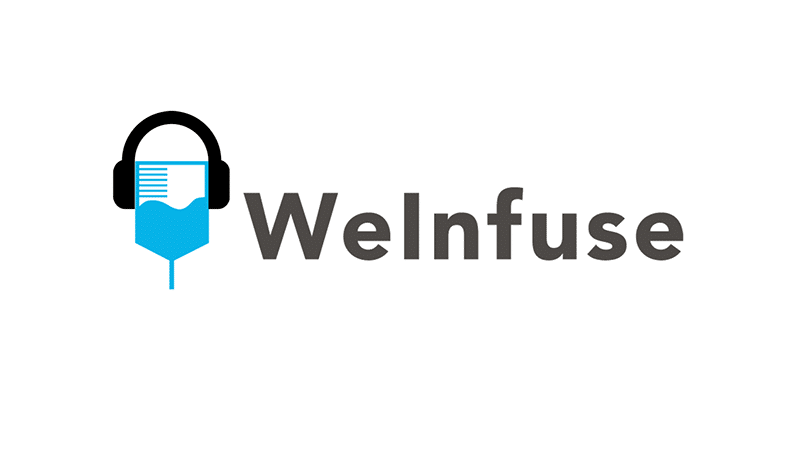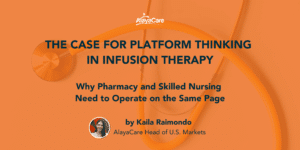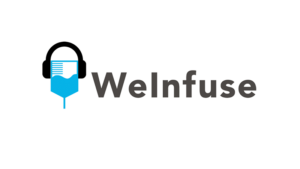Chuck DiTrapano, RPh, Founder and Vice President of Pharmacy Education with RxToolKit, joins us to offer insight on creating systems to enhance the safe administration of medication for both patients and caregivers. To learn more about RxToolKit and their journey for a safer infusion experience, visit www.rxtoolkit.com
Follow on Amazon Music II Subscribe to Podbean II Subscribe to iTunes
Transcript: How to Enhance Medication Safety for Patients & Caregivers
Amanda Brummitt: We Infuse podcast, episode number 46. Welcome to the We Infuse podcast. My name is Amanda Brummett. In every episode, we give you a seat at the table as we talk to infusion center owners, operators, and experts so that you can get the insight you need to run a thriving practice. In this episode, we talk with Chuck DiTropano, founder and vice president of pharmacy education with RxToolkit. We’ll get a snapshot into Chuck’s fascinating journey into medication safety, along Learn why he had to be part of the solution and get insight into how RxToolkit saves lives. As I shared, I’m super excited to be here today with Chuck DiTropano from RxToolkit. Thank you so much for being here, Chuck.
Chuck DiTrapano: Thank you. Welcome. Glad to be here.
Amanda Brummitt: Yeah. So I absolutely wanted to get into how you’ve made medication administration safer for both patients and caregivers. But before we get into that, can you give our listeners a snapshot of your professional background prior to creating RxToolkit? RxToolkit.
Chuck DiTrapano: Sure. I’m a graduate of the Albany College of Pharmacy in Albany, New York, which is my hometown. right after graduating pharmacy school, I, I was during Vietnam and, I ended up joining the, New Jersey, the New York National Guard as an army medic. I had always wanted, I went to military high school, so I’d always wanted to be an officer in the military. So one day I decided to join the United States Navy. I got a direct commission as a lieutenant and became a pharmacy officer. My initial duty station was in Bethesda, Maryland. And then from there I went to Philadelphia, Pennsylvania. The duties of a hospital pharmacist in the Navy are similar to the duties of a civilian pharmacist as a hospital pharmacist, although we had a much. We had a very large outpatient setting as well as an inpatient setting, got involved in the infusion therapy actually there when this was when infusion therapies by pharmacy were relatively new. many of the IVs were, not being mixed by pharmacy, in those days. subsequent to that, I left the Navy and held various jobs, in various career positions, and ended up becoming an executive of several large Pharmacy organizations primarily devoted to institutional pharmacy, which is nursing home pharmacy. I became a vice president at a company called Vitalink, which was a national company and I was vice president of operations for them. And then they were subsequently acquired. And I went to work for Omnicare, which is the largest provider of institutional pharmacies, which is now owned by CVS, and became in charge of their, I was a vice president in charge of their assisted living division. but by then I had spent maybe 15 years not practicing as a pharmacy. And quite honestly, I missed the profession. I missed being a pharmacist. I, And so I, up and quit my job, moved back to Pennsylvania, where my home was, from actually going from the Navy and, joined the Reading hospital as a hospital pharmacy supervisor, which was in 2001, immediately became aware of. The difficulties pharmacists were have would have with keeping up with all the different technology and content. if you walk around the hospital, you’ll see people with notepads and index cards and binders. And so I decided that I went to my boss one day and I said, how do you know what to do? people are doing. How do you know that pharmacist A is making the same clinical decision as pharmacist B when it’s relevant, to a certain patient condition? And, I said, I think I can fix that. So the first thing I did is I actually created a paper binder. I gathered content from, we had about 40 pharmacists at the time and I gathered content from as many as I could put it into a paper binder. it was about a three or four inch binder and then said, there’s probably a better way to do this than making it a binder. and my, partner, who’s my partner now, John Neville, who’s the C I was the CIO for, RX toolkit, I called him up and I asked him, I said, I would like to be able to basically consolidate information into a place where people could search it. And everybody would be working off the same sheet of music. So him and I got together. We designed the beginnings of RX toolkit. I presented it to my boss at Reading hospital, and, we launched it maybe eight months later. That’s how it got to where I am today. I guess
Amanda Brummitt: that is amazing. Don’t you feel like every good start story starts with I up and quit my job.
Chuck DiTrapano: Yeah. I took a pay cut. Probably, two thirds. it was, I, it was funny because one of my, one of my colleagues at Omnicare who was, a clinical pharmacist, he used to call me clinically dead because I didn’t know anything anymore. I, hadn’t really practiced it. I can tell you that when I graduated pharmacy school, the drugs that are available today, probably 95 percent of them didn’t exist back then. So, you know, any health care position is a continuous learning process. You, can’t read. And I assume that’s the same with any condition with any profession. And so I wanted to be able to survive. And by doing, building the binder, and then subsequently creating RX toolkit, I was educating myself at the same time as I was providing a resource. It was a survival process for me. because. You sometimes are put into situations where you need to be able to have information, accurate information, to be able to do what you need to do for the patient.
Amanda Brummitt: Absolutely. Well, I understand that you have a really impactful story around patient safety and NICU saves. Can you talk about that and how it ultimately ended up with you creating RxToolkit?
Chuck DiTrapano: Well, there was a story going around about a young girl, a two year old girl, in Cleveland, who died as a result of a medication error. And, I had a near miss. A near miss is when you, a medication error doesn’t reach the patient. It was a very busy day, and I was checking IVs and I had a whole, you have a timeline to get the IVs checked by because everybody has to go out and deliver them. And I had this big stack of IVs and I was checking them. And I, always use the, my entire career, I use the blue Sharpie, and put my signature was a C with a blue Sharpie. And I kept checking all these IVs. And, for whatever reason, I checked one, put it into the check pile, and then like two checks later, I thought, wait a minute, that wasn’t right. And I brought it back. and it turned out that it was incorrect. and that really scared, it was, it could have been a really serious medication error and it really scared me. Scared me. So I began to research more about the Eric, the story around this little girl, whose name was Emily Jerry. and as I researched it, I found out that the pharmacist who made the error was in a similar situation as I was, he was being, it was a, the pharmacy computer system had been down, it was like one of those perfect storms, he had a timeline, people were calling him, where’s my IV. he went through the process and a technician. Had run out of normal saline, which is a diluent that they use for IVs and, decided to make her own. but she made it using concentrated sodium chloride, 23. 4%, but didn’t dilute it. Eric didn’t catch that error that the technician made. and subsequently that, that drug was administered to Emily and Emily died as a result of that. Eric ended up going to jail. there’s a whole story behind the scenario, but he ended up going to jail, serving hard time. and I was aware of that and thought, put for the grace of God, go I, this sort of thing. And I decided I really wanted to talk to him to understand his experience. So, I knew that a fellow by the name of Mike Cohen, who’s the president of the Institute of Safe Medication Practices, was a friend of mine, and I asked him if he could get ahold of Eric for me. And so long story short, I got a hold of Eric. I invited Eric to come to Reading Hospital, primarily to speak to my department. By then I was the operations manager. I was in charge of the pharmacy operations. And I said, could you come down and speak to my staff? Well, it turned out that when the hospital got wind of it, they actually opened the doors and he spoke to multiple disciplines. He actually made several presentations. And Eric’s story was very compelling. and so, I learned from that, that, it’s, it can be very harmful to the second victim of a medication error, which is the caregiver. all of us that are in the profession got into the profession because we wanted to do good. The last thing we want to do is harm anybody. And it’s devastating. And if you look at it, there are, there are reports in the literature of people doing, going as far as committing suicide when they’ve made a catastrophic medication error. So that put me on the path to say, I really want to do something to help myself and the colleague, my colleagues, prevent these errors from occurring.
Amanda Brummitt: Yeah, absolutely. I know that it’s more complex than a quick answer. But can you give us the overview of how our ex toolkit does that? How it protects both the patient and the caregiver?
Chuck DiTrapano: Well, I’ll give you a little history of how we got started. As I mentioned, we began in 2000 and four. We launched in june of 2000 and four. and we were basically a catalog of content of procedure manual primarily, but some drug information. But how that drug was used If you think about, how a drug is used, it may be used in the neonatal intensive care completely different than how it’s used in intensive care and completely different than how it’s used on a cardiac unit, in terms of the parameters and dosages and things like that. So we, we compiled that and segregated it into care settings. and then, and we, actually won the Institute of Safe Medication Practices Cheers Award that year for, innovations in medication safety. Cause in 2004, the internet wasn’t anything like it’s. It is today. come 2005. and up until then, we were just basically a content provider. We, we, had search tools and the like. In 2005, the joint commission on accreditation of hospitals put out a standard that said that Pediatric and NICU IVs had to be made, had to be standardized. Up until then, most practices used what’s termed as the rule of sixes. The rule of sixes makes it very easy, drugs are typically weight based. So the rule of sixes makes it very easy for a clinician to prescribe and for a nurse to titrate. But that means every day, The pharmacy has to make a different concentration. So on one day, it’s this much dopamine and D5W. And the next day, it’s a little bit different because in these little infants and children, their weights change on a daily basis. And in a neonatal intensive care, as an example, it can change significantly in terms of a percentage of overall weight. So, the hospital was faced with the dilemmas and they wanted to be able to standardize it. So the head of the patient safety team came to me and said, Is there anything you could think about doing? That would help us and we built an application that is still in use today. and this is 2005 to standardize. The administration of neonatal intensive care so that the pharmacy always made the steam the same, but we gave the clinician at the bedside the tools to be able to understand how to titrate it. So if you want one milligram per kilogram per minute, this is what you do to a two milligram microgram per kilogram per minute, this is what you do, that kind of thing that put us on the road of building apps. we, changed from a content provider. to a resource tool. And over the years, we built, I believe, 22 different applications, not all clinical. some are, we’re non clinical, but, most of the, all of the neonatal intensive care products and pediatric products that are in the system that we built are still in use today at Reading Hospital. and we have two saves. One of our, a physician was woken up three o’clock in the morning, was asked to prescribe a infusion concentration for a baby made a, an error, a, a multiple fold error. the, pharmacist who checked it, put it through RX toolkit, Recognize the error. The pharmacist called the supervisor on call because it was like 3 o’clock in the morning and the supervisor on call confirmed it by logging into our toolkit and doing the same thing. And, we prevented that error from happening or ever reaching the patient. And another instance, we provide, if you think about a crash cart. and a crash cart can have a significant number of drugs when you’re dealing with an infant that might be, less than one kilogram, you, the dosing is, it has to be extremely precise. And we built a tool, where we took every drug in, the. Entire crash cart. And we allowed the user to put the patient’s weight in. We actually, we maintain the patient’s weight. So every day, every time a new NICU baby is born, that document has to be, my policy has to be presented and put on the chart so that if that baby does crash, all the doses are calculated, including. Right down to the milliliter, in terms of how many what the volume would be. what had happened is that we used a kit for a drug called adenosine and the kit was stocked incorrectly. And as a result, the NICU nurse, when presented with the dose that she was to be administered based on the sheet, Looked at the kit and say, wait a minute, this kit, this concentration isn’t the same as what this sheet says, went and got another kit and administered the correct amount. So, that’s two that we know of.
Amanda Brummitt: That’s incredible. so you mentioned the Institute for Safe Medication Practices Cheers Award for medication safety. Can you tell us a little bit more about that?
Chuck DiTrapano: Well, they still have that Mike Cohen established this organization. It’s based out of Philadelphia. Mike was the director of pharmacy at Temple University hospital when I first met him and it’s a nationally recognized, resource for medication safety practices, and they offer each year about three or four awards to, for, in different categories. And, the one that we won was for technological innovation Medication safety. So john and I went down to Florida at the time and received the award. It’s sitting on my shelf over here.
Amanda Brummitt: Congratulations.<
Chuck DiTrapano: Yeah, thank you.
Amanda Brummitt: And I understand that our toolkit recently became a we infuse company. I’m curious why you chose to partner with we infuse.
Chuck DiTrapano: Well, I left Redding Hospital in 2017 with the intent of marketing RX toolkit to hospitals. So we were in the process of doing that, and one day out of the blue I got a call from this fellow named Brian Johnson and he said one of the things that we developed, one of those apps that we developed was a whole labeling system, repackaging system for hospitals. And he called me and said, I’ve seen some of your labels online. I’d like to learn more about them. So that was in 2017. That was my introduction to the We Infused folks. And I don’t know, you sometimes meet people that you just feel like you, you want to know better. And so over the years, we’ve, we’ve, exchanged, there were times when they would refer business to us or they would ask us questions. And, we, never really had a formal relationship, in terms of, a business relationship. we always knew we always consulted one another. One of their nurses would often, when, they worked, would call us and, Tell us, go talk to this company because they need some help. And so it introduced us to the infusion center market. And we started to grow in the infusion center market, with a lot of it, with, seed referrals from, the, we infuse folks. and, we got to meet him when we went to the, NICA convention nationals, The National Infusion Center Association meeting in Austin in 2019, And, just always felt really comfortable with them. and then one day Reese called me up and said, you know what? We think we might be able to do something together. So that was that. And it, my wife and I, Always said if there were a company that we would ever want to partner with, it would have been them. So I didn’t tell Reese that until after the negotiations, but it was just, it was some, there were, people that I wanted to work with because I felt that our philosophies about business were aligned. Our approach to customer satisfaction and customer service were aligned. our innovation to, to think out of the box and do things Differently was aligned and I learned those things about them, just interacting with them. And I thought, this could be synergistic. So it was, an easy decision on my part.
Amanda Brummitt: The great stories that don’t start with, I up and quit my job. Do you start with, I got a call from Brian or Reese.
Chuck DiTrapano: Yeah, exactly. I was fortunate enough to have both those things happen.
Amanda Brummitt: Speaking of that, can you share some, can you share some?
Chuck DiTrapano: I was just down in Dallas. And, the one thing that I do want to mention is that the. you have, a perception of what things are going to be like. And then when you get there and you see it, it’s better than I thought the exuberant, the youthfulness, this, I, was just, I just had breakfast with a neighbor of mine this morning and I said, I went down there and I saw some of the smartest, most innovative, creative. People compassionate. It just it was very helpful to me to be around such a wonderful group of people.
Amanda Brummitt: I totally agree. They get me fired up every time I talk to them.
Chuck DiTrapano: Yeah, and our client success person is a young lady by the mechanic deeds and she I couldn’t have asked for a better person to represent the company. And so I’m very excited about what the future holds for all of us.
Amanda Brummitt: Fantastic. So you mentioned a lot of names along the way. Are there, is there anybody else that’s been instrumental on your journey that you want to tell us about?
Chuck DiTrapano: My dad, was an immigrant, sixth grade education, came to this country, without, any knowing the language, and Just inspired me to, that there’s nothing you can’t do if you’re given the opportunity. And so you, you need to seize upon it. my brother, my, my brother was 10 years older than me. was a, you never back down. So he was a very inspirational person to me. I lost him, but I’m still very close to his children and my wife. my wife, Deb is. Just been a rock, so it’s those are the three most important people. I think that have influenced me through my life up to this point in terms of you know, quitting your job is scary But if you have somebody’s you know, you got to be able to do what you got to do sometimes So if it just feels right,
Amanda Brummitt: absolutely And my last question for you and it’s Twofold is your last piece of advice. And I would say both to our listeners who are mainly owners and operators of infusion centers, but then secondarily, based on some of the stuff you’ve shared any advice for clinicians out there, especially as they potentially are. or that second victim in the medication error. So advice to both our listeners and clinicians.
Chuck DiTrapano: RxToolkit is built around the drug. And to me, it’s, you got to know the drug and you got to know the drug and how it’s used in your, clinical practice setting. and don’t assume anything. and, there’s a reason why pilots have checklists, if a pilot’s been taken off and, up and down multiple times, they still do that checklist before they take off. And I think there’s a reason for that. And, don’t, ever make the assumption that you’ve got this without, just refreshing yourself. and the other thing is if, learn from your mistakes, learn from the errors, learn from the near misses, don’t submerge them, don’t push them underground. it’s the only way people will learn best practices is to be able to, learn from the errors and constantly reevaluate your process. and, include the people that are doing it. I’ve always believed that the people that are at that, at the front end, at the front, lines, really have the best information in terms of how to get, where the pitfalls are. So those are the things that, I, I’ve always tried to implement in my career.
Amanda Brummitt: Well, Chuck, thank you for all that you’ve given back to medicine, to caregivers, to patients, and thank you for being part of WeInfuse and for bringing RxToolkit to everyone.
Chuck DiTrapano: I’m excited, really excited. I feel 20 years old again.
Amanda Brummitt: What a great story. Chuck is not one to brag, but it’s truly inspiring how he took the initiative to create a safer place both for patients and clinicians in infusion centers, hospitals, and everywhere medications are administered. Well, if you haven’t done so already, do yourself a favor and give the WeInfuse software platform a test drive to see how it can save you time and money in your practice. And while you’re at it, be sure to ask the WeInfuse team about My name is Amanda Brummett and we’ll catch you in the next episode.
Guest Speaker:
RxToolKit Founder and VP of Pharmacy Education, Chuck DiTrapano, RPh is a pharmacist, seasoned healthcare executive, and military veteran. Before founding RxToolKit, Chuck served in various leadership roles within large healthcare organizations including Vitalink Pharmacy Services and Omnicare. Chuck served as the Operations Manager of Reading Health System’s Pharmacy from 2001 until 2017. At Reading, Chuck was inspired to start RxToolKit as he saw firsthand the need to enhance medication safety through process improvement.




